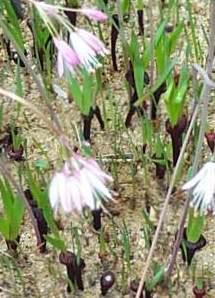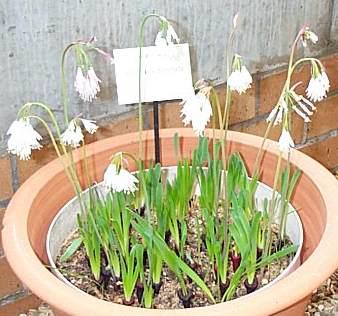Strumaria truncata
Strumaria truncata Jacq.
Family: Amaryllidaceae
Common names: Namaqualand snowflake
Introduction
Strumaria truncata is a charming bulbous plant, little known and unusual in cultivation.

Description
Description
Its globose bulb has a long neck and is covered with several layers of pale brown outer tunics. It produces a most attractive fan of up to six erect, usually spirally twisted leaves about 150 mm long and 10 mm wide. The lower parts of the green or greyish-green leaves are surrounded by a striking deep reddish-maroon aerial sheath (known as a cataphyll in botanical terms) which supports the base of the leaves. Strumaria truncata is the only species in the genus that produces this curious aerial sheath.

The flower head is an umbel and is produced on a long slender stem with the flowers usually hanging downwards. The funnel-shaped flowers are usually bright white, but also vary in shades of pink depending on the wild locality, and have conspicuously protruding, long stamens. During the fruiting period, the flower stalks lengthen and become erect, and produce bright green or dull reddish-brown, round fleshy seeds which drop to the ground once they are ripe and begin to germinate almost immediately. The flowering period is April to June in the Southern Hemisphere, and individual flowers are quite long-lasting, remaining attractive for about ten to twelve days.
The leaves of the various species vary from very narrow and grass-like to relatively broad with blunt tips, and in several species are produced in an attractive fan. The leaves of some species are densely covered with soft hairs, but most species have smooth shiny leaves. The flowers vary in colour from pure white as in Strumaria barbarae from southern Namibia, to bright pink as in Strumaria salteri from the north-western parts of the Western Cape.
Distribution and habitat
Distribution description
Strumaria is a most interesting, ornamental dwarf bulbous genus comprising about twenty-five species, which is endemic mainly to the dry winter rainfall parts of Namibia and South Africa. Only one species, Strumaria tenella subsp. orientalis occurs in the mainly summer rainfall parts of South Africa where it is found in the southern Free State as well as in Lesotho.
Strumaria truncata occurs in the western parts of the Northern Cape, usually on south-facing slopes of rocky outcrops, in sandy or clay soils.
Uses
Use
The genus is very poorly known in cultivation and is usually grown by specialist bulb collectors, as most species have stringent cultivation requirements, which have to be met for successful flowering to occur. Strumaria truncata is one of the easiest and most attractive of the species to grow. It is best grown as a container subject as its bulbs must be kept absolutely dry during the summer dormant time, and cannot survive garden irrigation during this period.

Growing Strumaria truncata
Grow
The bulbs are best suited to a shallow 25 cm diameter plastic or terracotta pot, and are planted with the top of the neck of the bulb exposed just above ground level. The growing medium must be very well drained and should preferably be a mix of equal parts of coarse river sand and industrial sand (swimming pool sand), with a layer of fine, well-decomposed compost placed at the bottom of the pot. Ensure that large stone chips are placed over the drainage holes at the bottom of the pot to prevent the soil medium from washing out.

The bulbs are planted in early autumn after which they should be given a good watering, and then not again until the flower buds and leaves begin to appear, whereafter they can be watered well every two weeks. For best results, place the pots in a position where they will receive morning sun and afternoon shade. Resist the temptation to water more frequently as this plant detests constantly wet feet, which will soon lead to rotting of the roots and bulbs. Towards the end of spring, as temperatures rise, the leaves will begin to yellow, and watering must then cease completely to allow the soil medium to dry out. The pots can then be stored in a cool dry place for the summer months.
The easiest method of propagating Strumaria truncata is by seed, as offsets form rather slowly, if at all. Seed is produced in large quantities and there is no need to hand-pollinate the flowers, as they are self-fertile. Seeds are ready to be harvested once they are easily detached from the ripe capsules, but be careful not to squash them, as they are fleshy and easily damaged. Sow the seeds in the same medium recommended for cultivating bulbs. Sprinkle them evenly and thinly over the soil medium and then cover them with about 3 mm of the medium. Water well with a fine rose and place in a protected position with good air circulation and which receives morning sun. Once the seeds have germinated and produced their first leaves (within 10-12 days), water them well every two weeks. Seedlings generally flower for the first time during their third season, but under ideal conditions flowers may appear during the second year of growth.
Strumaria truncata is generally pest- and disease-free, but mealy bugs do attack the leaf bases and are best treated by drenching the soil medium with a chlorpyriphos solution during the growing period. Lily borer (also known as amaryllis caterpillar) occasionally attacks the foliage and can be combatted by spraying the foliage with a carbaryl-based insecticide in severe infestations.
Bulbs and seeds of Strumaria truncata are difficult to obtain, but specialist bulb nurseries such as those which advertise in Veld & Flora, the quarterly journal of the Botanical Society of South Africa, do occasionally list them.
References
- Duncan, G.D. 1989. Strumaria. In: Du Plessis, N. M. and G.D. Duncan, Bulbous Plants of Southern Africa. Tafelberg, Cape Town.
- Duncan, G.D. 2000. Grow Bulbs. Kirstenbosch Gardening Series. National Botanical Institute, Cape Town.
- Snijman, D.A.1994. Systematics of Hessea, Strumaria and Carpolyza in Contributions to the Bolus Herbarium.16:1-162.pp.
Credits
Graham Duncan
Kirstenbosch National Botanical Garden
April 2002
Plant Attributes:
Plant Type: Bulb
SA Distribution: Northern Cape, Western Cape
Soil type: Sandy
Flowering season: Autumn
PH: Acid, Neutral
Flower colour: White, Pink
Aspect: Morning Sun (Semi Shade)
Gardening skill: Average
Special Features:
Horticultural zones








Rate this article
Article well written and informative
Rate this plant
Is this an interesting plant?
Login to add your Comment
Back to topNot registered yet? Click here to register.